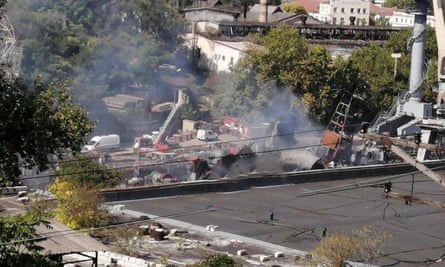A Ukrainian missile strike on a shipyard in occupied Crimea has severely damaged and possibly destroyed a Russian amphibious landing ship and a Kilo-class submarine, satellite footage shows.
If confirmed, the direct hit to the vessels in Sevastopol on Wednesday would mark one of the most devastating strikes against the Russian navy in the war, and the largest since the sinking of the Moskva guided missile cruiser in 2022.
In a second day of strikes in Crimea, Ukrainian forces claimed to have destroyed an S-400 air defence system on Thursday. Video published on social media showed large explosions near Yevpatoriya, on the occupied peninsula’s south-west coast, where Ukraine said Russia had stationed the air defence system.
Additional footage of a secondary strike/explosion in Russian-occupied Yevpatoriya pic.twitter.com/mvD6pLI325
— OSINTtechnical (@Osinttechnical) September 14, 2023
Satellite footage showed that the missiles had struck a Russian anti-aircraft position that had previously been identified in social media posts, Radio Free Europe reported.
The earlier Ukrainian cruise missile strike that hit a shipyard in Crimea on Wednesday caused large explosions at a major centre for the construction and repair of vessels in the Russian Black Sea fleet. The damage to the ships could disable the local dry docks until the debris is cleared.
“Satellite imagery published on September 12 shows one Ropucha-class landing ship and one Kilo-class submarine at the dry dock, and satellite imagery published on September 13 shows that the Ukrainian missile strike likely destroyed the two vessels,” wrote the Institute for the Study of War, a Washington DC-based thinktank that regularly publishes analysis of the conflict.

Russian military officials said two vessels were hit in the attack and the scope of the damage was unclear. A Ukrainian military intelligence official claimed the strike may have destroyed several ships.
“Considerable damage has been inflicted and we can now say that the vessels are most likely not recoverable,” Andriy Yusov, a Ukrainian military intelligence spokesperson, said in a televised interview. “Yes, today there’s good news – the destruction of the large enemy landing ship … as well as the Kalibr-carrying submarine, which is very important.”
Satellite footage of the shipyard published late on Wednesday showed severe damage to the Minsk, a Ropucha-class amphibious ship, and to the Rostov-na-Donu, an improved Kilo-class submarine. The submarine is capable of carrying Kalibr cruise missiles, which have been fired regularly by Black Sea fleet ships in attacks on Ukraine.
The ISW wrote: “The apparent destruction of the two vessels will likely render the dry dock inoperable until Russian forces can clear the debris, which may take a significant amount of time. The extent of the damage to repair facilities beyond the dry dock is unclear, and any damage to one of the Russian Black Sea fleet’s main repair facilities in occupied Crimea will likely have reverberating impacts in the event of further [Ukrainian] strikes on Russian naval assets.”
Russian and Ukrainian sources have reported that the strike against the shipyard was carried out using Storm Shadow missiles delivered by the UK and launched from Ukrainian aircraft. The head of the Ukrainian air force thanked his pilots for their “excellent combat work” shortly after the Sevastopol strike.
Russia has not lost a submarine in combat since 1945 and the last peacetime loss of a submarine came in the early 2000s.
The strike on the Russian air defence missile systems was probably carried out using Neptune cruise missiles, which are designed to be used against ships.
The satellite footage showed a number of craters near the site of an S-400 battery on the coast of Crimea previously identified in photos taken by tourists in 2022. In the raid, Ukrainian drones first targeted radar infrastructure to blind the Russian defences and then the Neptune cruise missiles engaged the anti-aircraft battery.